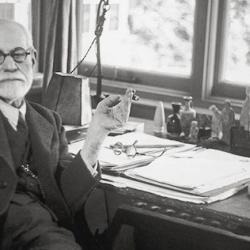In an editorial introduction to King Lear, GK Hunter observes that the play depicts three forms of madness. First, “The Fool has a quality of savage innocence that the other two lack. . . . His stock consists in the main of songs and riddles, nonsense-rhymes and a mock prophecy. These he deploys as oblique and self-protective comments on the real world. . . . He is a living manifestation of that world of irony and metaphor in which every experience can throw light on every other one, in which Lear too would ‘make a good food,’ and which the daughters seed to reduce to the literalism of appetite. In such a world, where bitterness and innocence, correction and irresponsibility effortlessly co-exist, it is pointless to ask if he is mad or sane. He knows as much as the next man; but he is exempted from the need to put his knowledge in logical order” (518-9).
Poor Tom (Edgar) is possessed and exemplifies Shakespeare’s interest in “the idea of man in the grip of an identity he believes he can control but which assumes a reality in the world outside which he never anticipated. Poor Tom is in thrall to his obsessions, cold, hunger, lice and other incommodities, which he expresses as the local effects of ‘the foul fiend,’ but which we (like Lear) may see as the basic features of unprotected humanity.” In this sense, “we are all in danger of ‘possession.’” While the Fool sees folly, Tom sees “torment. His vision is of Hell; his song-snatches are free-wheeling phantasmagorias, not pointed social comments like the Fool’s” (519).
Lear himself doesn’t trade in song and riddle, but in “the sermon, the prayer, and the trial. His role is always the commanding one; though he may become a voice rather than a person, his is always the leading voice” (519). Lacking patience, he breaks into pieces: “Patience would be a way of expressing man’s need, if it could in fact hold together the various passions—rage at injustice and hypocrisy; pity for the oppressed, disgust at human depravity, incomprehension at offenses against that social solidarity of human beings that Shakespeare’s calls ‘kind.’” His madness involves “a bursting apart of the coherence which holds the hundred thousand flaws in a connected sequence.” And that fragmentation of the self arises from Lear’s detachment from all political and social moorings: “Lear asserts, in his sanity, that he cannot tell who he ism, for the defining family relationship is denied by his daughters. In the mad scenes it is not only the relationship between a man and his family that he finds denied; it is the whole sequence of loyalties, duties, and respects that everywhere in Shakespeare describes the final good” (520).
Detached from these networks of relation, man is no better than a beast: “If humankind cannot satisfy the individual’s need for a sense of himself, how then is man different from a beast?” “Man wears clothes” might be an answer, but Lear comes to realize that the clothes are expendable, mere “lendings”: that cover the “unaccommodated . . . forked animal” that he is.
And one of the sharp ironies of the play is that in all its forms madness offers truth that sanity cannot grasp. Blinded, Gloucester finally comes to see; mad, Lear attains sanity.















